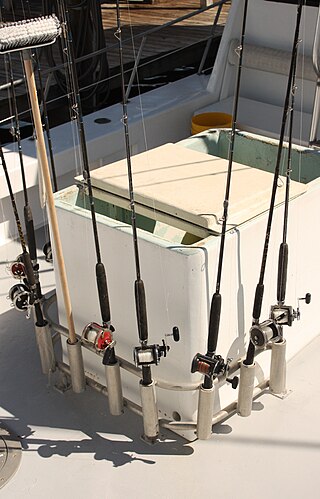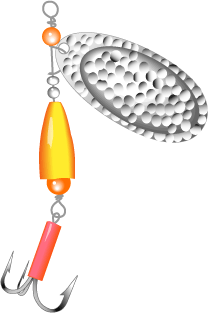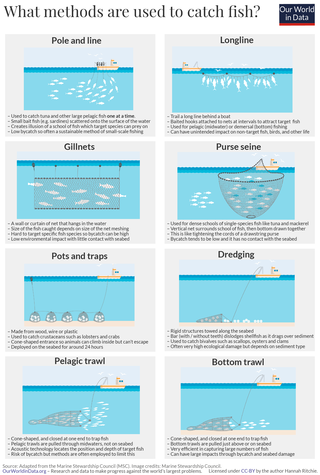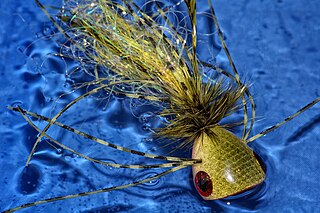Related Research Articles

Trolling is a method of fishing where one or more fishing lines, baited with lures or bait fish, are drawn through the water at a consistent, low speed. This may be behind a moving boat, or by slowly winding the line in when fishing from a static position, or even sweeping the line from side-to-side, e.g. when fishing from a jetty. Trolling is used to catch pelagic fish such as salmon, mackerel and kingfish.

A fishing rod is a long, thin rod used by anglers to catch fish by manipulating a line ending in a hook. At its most basic form, a fishing rod is a straight rigid stick/pole with a line attached to one end ; however, modern rods are usually elastic and generally have the line stored in a reel mounted at the rod handle, which is hand-cranked and controls the line retrieval, as well as numerous line-restricting rings that distribute bending stress along the rod and help dampening down/prevent line whipping and entanglement. To better entice fish, baits or lures are dressed onto the one or more hooks attached to the line, and a bite indicator is used, some of which might be incorporated as part of the rod itself.

A fishing reel is a hand-cranked reel used in angling to wind and stow fishing line, typically mounted onto a fishing rod, but may also be used on compound bows or crossbows to retrieve tethered arrows when bowfishing.

A fishing line is any flexible, high-tensile cord used in angling to tether and pull in fish, in conjunction with at least one hook. Fishing lines are usually pulled by and stored in a reel, but can also be retrieved by hand, with a fixed attachment to the end of a rod, or via a motorized trolling outrigger.

Fly fishing is an angling technique that uses an ultra-lightweight lure called an artificial fly, which typically mimics small invertebrates such as flying and aquatic insects to attract and catch fish. Because the mass of the fly lure is insufficient to overcome air resistance, it cannot be launched far using conventional gears and techniques, so specialized tackles are used instead and the casting techniques are significantly different from other forms of angling. It is also very common for the angler to wear waders, carry a hand net, and stand in the water when fishing.

Angling is a fishing technique that uses a fish hook attached to a fishing line to tether individual fish in the mouth. The fishing line is usually manipulated via a fishing rod, although rodless techniques such as handlining also exist. Modern angling rods are usually fitted with a fishing reel that functions as a cranking device for storing, retrieving and releasing out the line, although Tenkara fishing and traditional cane pole fishing are two rod-angling methods that do not use any reel. The fish hook itself can be additionally weighted with a denser tackle called a sinker, and is typically dressed with an appetizing bait to attract and entice the fish into swallowing the hook, but sometimes an inedible fake/imitation bait with multiple attached hooks is used instead of a single hook with edible bait. Some type of bite indicator, such as a float, a bell or a quiver tip, is often used to relay underwater status of the hook to the surface and alert the angler of a fish's presence.

Catch and release is a practice within recreational fishing where after capture, often a fast measurement and weighing of the fish is performed, followed by posed photography as proof of the catch, and then the fish are unhooked and returned live to the water. Using barbless hooks, it is often possible to release the fish without removing it from the water.

Recreational fishing, also called sport fishing or game fishing, is fishing for leisure, exercise or competition. It can be contrasted with commercial fishing, which is professional fishing for profit; or subsistence fishing, which is fishing for survival and livelihood.

Jigging is the practice of fishing with a jig, a type of weighted fishing lure. A jig consists of a heavy metal sinker with an attached fish hook that is usually obscured inside a soft lure or feather-like decorations. Jigs are intended to create a jerky, vertical "jumping" motion to attract fish, as opposed to other common lures like swimbaits, spoons and spinnerbaits, which move through the water more or less horizontally. The jig is very versatile and can be used in both salt and fresh water. Many deeper water fish species are attracted to the lure, which has made it popular among anglers for years.

A fishing lure is any one of a broad category of artificial angling baits that are inedible replicas designed to mimic prey animals that attract the attention of predatory fish, typically via appearances, flashy colors, bright reflections, movements, vibrations and/or loud noises which appeal to the fish's predation instinct and entice it into gulping the lure. Angling activities using lures are known as lure fishing.

A fish hook or fishhook, formerly also called an angle, is a hook used to catch fish either by piercing and embedding onto the inside of the fish mouth (angling) or, more rarely, by impaling and snagging the external fish body. Fish hooks are normally attached to a line, which tethers the target fish to the angler for retrieval, and are typically dressed with some form of bait or lure that entices the fish to swallow the hook out of its own natural instinct to forage or hunt.

Handline fishing, or handlining, is a fishing technique where a single fishing line is held in the hands, rather than with a fishing rod like the usual angling, of which handlining is a subtype. Handlining is not to be confused with handfishing, which is catching fish by hand. When handlining, one or more fishing lures or baited hooks are attached to the line, and a fishing lure and often a weight and/or a fishing float can also be attached to the line. Handlining is among the oldest forms of fishing and is still practiced throughout the world today.

In angling, casting is the act of the angler throwing the bait and hook as well as other attached terminal tackles out over the water, typically by slinging a fishing line manipulated by a long, elastic fishing rod. The term itself may also be used for setting out a net when artisanal fishing.

A trotline is a heavy fishing line with shorter, baited branch lines commonly referred to as snoods suspending down at intervals using clips or swivels, with a hook at the free end of each snood.

Fishing tackle is the equipment used by anglers when fishing. Almost any equipment or gear used in fishing can be called fishing tackle, examples being hooks, lines, baits/lures, rods, reels, floats, sinkers/feeders, nets, spears, gaffs and traps, as well as wires, snaps, beads, spoons, blades, spinners, clevises and tools that make it easy to tie knots.
A sabiki or flasher rig is typically fished off boats, piers, jetties, or any structure over the water. Sabikis consist of any number of small hooks, each one on individual dropper lines that are a few inches long. The individual dropper lines are then tied to a longer leader in series, about 6 inches (15 cm) apart; a weight is tied to the end of the leader. Alternatively, a larger lure or plug can be used at the end. This creates the illusion that a medium-sized fish is chasing 6 to 10 smaller fish.

Fishing techniques are methods for catching fish. The term may also be applied to methods for catching other aquatic animals such as molluscs and edible marine invertebrates.

The popper is an effective and proven lure designed to move water using a concave or hollowed nose. Poppers aim to simulate any sort of distressed creature that might be moving or struggling on the surface of the water. Poppers are used with spin fishing and fly fishing.
Drop shotting is a highly finesse angling technique using plastic baits, consisting of a small thin-wire hook with a weight (sinker) attached to the tag end of the line. This is in contrast to the more traditional Texas Rig, where the weight slides inline, resting on the nose of the bait; or the Carolina Rig, where the weight is fixed above the bait. The dropshot rig provides the ability to keep a hook and lure off the bottom with a more "weightless"-looking posture. Usually the bait is fished by letting the weight hit the bottom and then twitch the rod tip, causing the lure to shake in a jumping-like action, but can also be flipped, dragged, hopped or jigged along the bottom. This simple but versatile technique has endless combinations with the different hooks, soft plastics and weights that can be used.[1] The aim is to present a free floating, slow twitching lure to induce a strike from non-aggressive fish. This rig is commonly used in bass fishing for catching smallmouth, largemouth and spotted bass, but can be used for a variety of other bottom-dwelling fish species, as well.

Fishing bait is any luring substance used specifically to attract and catch fish, typically when angling with a hook and line. There are generally two types of baits used in angling: hookbaits, which are directly mounted onto fish hooks and are what the term "fishing bait" typically refers to; and groundbaits, which are scattered separately into the water as an "appetizer" to attract the fish nearer to the hook. Despite the bait's sole importance is to provoke a feeding response out of the target fish, the way how fish react to different baits is quite poorly understood.
References
- ↑ Tim Allard (6 June 2013), The Fishing Basics You Need to Know to Set a Hook, BassPro
- ↑ Peter Kaminsky; Greg Schwipps (2011), "Setting the hook with circle hooks", Fishing for Dummies, John Wiley & Sons, ISBN 9781118000502
- ↑ David Tieszen (1998), "Setting the Hook", Fishing Dry Flies, Quarto Publishing Group USA, pp. 82–3, ISBN 9781610602938
- ↑ Peter Kaminsky; Greg Schwipps (2011), "Setting the hook with J hooks", Fishing for Dummies, John Wiley & Sons, ISBN 9781118000502

